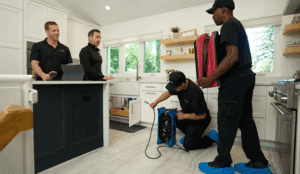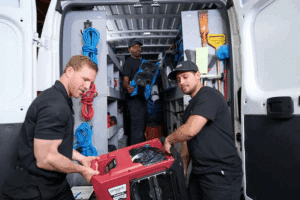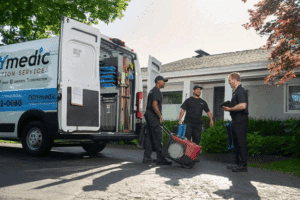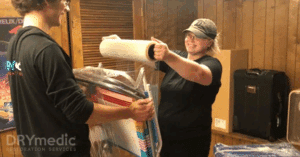What if the first item you grab is a mop when the smartest move is to step back and rethink the plan?
We talk with clients who discover a sewage backup and instinctively start scooping, spraying, and scrubbing. It feels proactive. It also creates unnecessary exposure to contaminants and spreads the mess into places that were not affected. In this guide we explain the real risks of DIY cleanup, what a safe response looks like, and how to protect your property and your health. We keep the tone practical and focused since this is an informational resource from DRYmedic.
Table Of Contents
- The Part Most People Underestimate Is The Water Itself
- Health And Safety Exposures That Diy Often Overlooks
- The Property Damage You Cannot See From The Doorway
- Why Professional Protocols Reduce Risk
- What To Do In The First Hour While Help Is On The Way
- Common Diy Myths We Clear Up With Clients
- When Materials Must Be Removed Rather Than Cleaned
- Costs, Insurance, And Documentation That Helps Your Claim
- What We Encourage Clients To Ask Before Anyone Starts Work
- Why Diy Often Costs More In The Long Run
- Closing Thoughts For Homeowners And Property Managers
- FAQs
The Part Most People Underestimate Is The Water Itself
Here is a question we ask as soon as we arrive. What category of water are we dealing with and which materials did it reach?
Sewage is considered Category 3 water by industry standards. Category 3 is grossly contaminated and may contain pathogens and other harmful agents. That classification alone sets a high bar for protective equipment, containment, removal of affected materials, and disinfection steps.

When DIY efforts begin with towels and household disinfectants, the work skips over the safeguards that go with Category 3 conditions. That can expose you to contaminants and can push polluted water into wall cavities, under trim, and across clean rooms through shoes, mops, and shop vac hoses. Many competitor guides warn about health risks from bacteria and viruses and recommend professional help for sewage events. We agree with that perspective because the risks are not theoretical.
Why the air matters as much as the floor
Another question to consider. What happens when you start moving air across contaminated surfaces?
Fans without proper filtration can aerosolize particles from sewage. Airflow that is not part of a controlled setup can carry contaminants to adjacent rooms and into HVAC returns. Guidance from infection control resources highlights that water impacted by fecal contamination can carry organisms that colonize surfaces and systems. This is one reason we isolate the affected area and manage airflow in a deliberate way.
Health And Safety Exposures That Diy Often Overlooks
We know it feels productive to start cleaning right away. We also know which pitfalls turn a quick cleanup into a bigger problem.
Skin and respiratory exposure
Category 3 water can contain microorganisms and parasites. Handling contaminated materials without the right PPE increases the chance of skin contact, inhalation of aerosols, and transfer to clean areas like kitchens or children’s rooms. Competitor resources echo the same message. Leave raw sewage handling to trained teams that follow strict protection and hygiene protocols.

Cross contamination through tools and pathways
A mop, a wet vac, or a pair of boots can carry sewage from a laundry room into a hallway or up a stair. Once contamination spreads, the footprint expands and costs rise. Several restoration guides point out that improper cleanup can damage finishes and weaken structures when moisture lingers.
Hidden moisture that feeds future mold
Sewage water soaks into porous materials and wicks behind baseboards. If damp pockets remain, mold can follow. Industry blogs commonly note that mold can take hold quickly after a wet event if conditions are right, which is why drying and verification matter after sewage is removed.
Electrical and mechanical hazards
Basements and utility rooms contain appliances, outlets, and power strips. Entering a wet area without securing utilities can be dangerous. Competitor guidance emphasizes shutting off electricity and avoiding contact with plugged in devices in affected spaces.
The Property Damage You Cannot See From The Doorway
What if the room looks better after a surface wipe but the subfloor is still saturated?
Porous materials like carpet pad, drywall, insulation, and particleboard absorb contaminated water. Even if surfaces appear clean, the materials underneath can hold moisture and contaminants. DIY cleanup that focuses on visible sludge and odor often leaves the lower two inches of drywall wet and the carpet pad saturated. That is where secondary damage starts. Over time seams can swell, fasteners can rust, and odors can return.

Where sewage water likes to hide
- Under baseboards and along the bottom edge of drywall
- In carpet padding, tack strips, and transitions between rooms
- Beneath vinyl or laminate flooring where seams trap moisture
- Inside lower kitchen and bath cabinets and behind toe kicks
- In wall cavities where insulation slows drying
We trace these pockets with moisture meters and open small access points as needed. That approach limits tear out and speeds safe drying.
Why Professional Protocols Reduce Risk
Another question worth asking. What separates a safe cleanup from a risky one?
Source control and stabilization
We confirm the cause, stop the flow, and evaluate whether a plumber is needed for a main line clog. Competitor checklists often start with similar steps because clearing the line prevents a repeat surge during cleanup.
Containment and protection
We set up containment to isolate the affected zone and select PPE based on the category of water and the tasks ahead. Category 3 conditions call for elevated precautions compared to routine cleaning.
Extraction, removal, and disposal
Bulk contaminants are removed with the right tools and disposal methods. Porous items that cannot be cleaned are bagged and discarded per local rules. Nonporous surfaces are cleaned and disinfected in a sequence that avoids cross contamination.

Drying with verification
Air movers and dehumidifiers are placed to create controlled drying. We monitor moisture and compare readings to unaffected areas until normal values are reached. This step prevents the slow return of odors and the conditions mold prefers.
What To Do In The First Hour While Help Is On The Way
Could a few small actions make a big difference without putting you at risk?
- Keep people and pets out of affected rooms
- If it is safe, shut off electricity to the specific area using the breaker and avoid contact with appliances that sit on the floor
- Do not run central HVAC that could pull air from the affected area into the rest of the home
- Place aluminum foil or plastic under furniture legs in dry adjacent rooms to prevent transfer if moisture spreads
- Avoid mopping or vacuuming raw sewage
Small, careful steps limit spread without exposing you to the hazards of direct cleanup.
Common Diy Myths We Clear Up With Clients
Bleach fixes everything
Household bleach does not penetrate porous materials and loses strength quickly on dirty surfaces. On drywall, carpet pad, and unsealed wood it cannot reach contaminants that sit below the surface.
Shop vacs are a cure all
A shop vac can pick up water but it can also aerosolize contaminants and push them into clean rooms through exhaust. It is not a substitute for professional extraction with proper filtration and disinfection.
If it smells better it is safe
Odor can fade while moisture and microbes remain. We rely on measurements and material assessment, not smell.
If the backup was small there is no health risk
Any amount of Category 3 water calls for caution. Even a small overflow can contaminate a broad area through wicking and traffic.

When Materials Must Be Removed Rather Than Cleaned
We always try to save what can be saved. We also protect you from future problems.
Carpet pad, particleboard, fiberboard baseboards, and the bottom edge of saturated drywall often need removal in a sewage event. Nonporous items like tile, sealed concrete, and certain plastics can usually be cleaned and disinfected. Cabinets and toe kicks depend on construction and saturation. Opening small sections for access can prevent large tear outs later.
Costs, Insurance, And Documentation That Helps Your Claim
Why does thorough documentation help as much as the cleanup itself?
Adjusters look for cause, scope, and proof that materials were addressed correctly. We record moisture readings, take photos of affected areas, and note which items were cleaned or removed. This organized record speeds approvals and reduces back and forth. Many competitor resources point out that immediate mitigation and clear documentation are keys to a smoother claim.
What We Encourage Clients To Ask Before Anyone Starts Work
- Which areas tested wet and how far did the moisture spread
- What will be cleaned vs removed and why
- How will you isolate the workspace and protect clean rooms
- What measurements will show that the home is dry and safe
- How often will you check and adjust equipment
These questions keep the process transparent and help you understand the path from contamination to clean.
Why DIY Often Costs More In The Long Run
Would you rather pay for one complete fix or pay twice after problems return?
DIY cleanup can leave contamination behind and can hide moisture that drives odors, staining, and mold. Once secondary damage sets in, replacement costs go up and disruption lasts longer. Paying for a safe, verified cleanup protects your health and your property value. That is the bottom line clients tell us matters most.

Closing Thoughts For Homeowners And Property Managers
If sewage reaches any porous material, assume the situation is more complex than it looks from the doorway. The risk is not only what you see on the floor. It is also what sits in the padding, the drywall, and the air. Professional protocols remove contaminants, prevent spread, and verify that materials reach safe moisture levels. We encourage you to protect your health and your investment with a response that fits the category of the water and the needs of the structure.
FAQs
What is the fastest safe action I can take after a sewage backup
Keep people and pets away from the area, secure electricity to the specific space if it can be done safely, and avoid running central HVAC. Wait for trained help that can isolate, extract, and disinfect correctly.
Why is sewage called Category 3 and why does that matter
Category 3 means the water is grossly contaminated and can contain harmful agents. This triggers strict safety and cleaning procedures that typical household products do not cover.
Can I keep carpet after a sewage backup
Carpet may be saved in some cases, but carpet pad and tack strips are often removed due to contamination. The decision depends on saturation, material, and the ability to clean and verify safely.
Will odors go away on their own after I clean the surface
Odors can fade temporarily while moisture and contamination remain in porous materials. Verification with meters and proper drying is the reliable way to confirm safety.
How do I prevent mold after sewage cleanup
Complete extraction, removal of unsalvageable materials, controlled drying, and moisture verification are the essentials. If you suspect growth later, review our Mold Remediation information to understand the next step.
Protect Your Health and Home with Expert Sewage Cleanup
→ Eliminate Dangerous Contaminants Safely
→ Prevent Structural And Mold Damage
→ Restore Your Property And Get Back To Focusing On Getting Life Back To Normal
★★★★★ Rated 5/5 by 35 homeowners for reliability, care, and complete recovery.